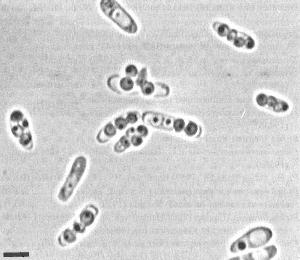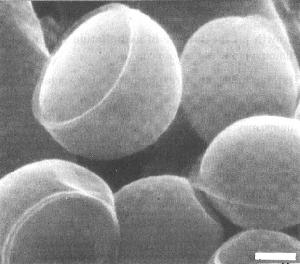

Pichia membranifaciens [P. membranaefaciens] produces organic acids and is a common food spoilage species. It is the type species of the genus Pichia, which was previously a polyphyletic group based largely on ascospore morphology. P. membranifaciens is often found as a film on the surface of table wine where it carries out oxidative metabolism. It will tolerate up to 11% ethanol by volume, and has occasionally been reported as a contaminant in sugar cane juice, sulfite fermentation plants and natural tequila fermentations (Lachance 1995). It produces acetaldehyde, ethyl acetate, and iso-amyl acetate (Rankine, 1966). Strains of P. membranifaciens have been reported with a strain dependent tolerance of 2 to 3 M NaCl, (Aguiar and Lucas, 2000), which probably accounts for its occurrence in olive brines (Oliveira et al. 2004). Despite its prevalence and apparent osmotolerance, P. membranifaciens has not been well studied from genetic or molecular biological perspectives. It has been reported to have between “two and eight” chromosomes (Naumov and Naumova, 2009).
- Aguiar, C. and Lucas, C. 2000. Yeasts
killer/sensitivity phenotypes and halotolerance. Food Technol.
Biotechnol. 38(1):39–46
- Lachance, M.A., 1995. Yeast communities in a
natural tequila fermentation. Antonie van Leeuwenhoek
68:151-160.
- Naumov, G.I., and Naumova E.S. 2009.
Microbiology Chromosomal differentiation of the sibling species
Pichia membranifaciens and Pichia manshurica. Microbiology
78:214-217.
- Oliveira, M., Brito, D., Catulo, L. et al.
2004. Biotechnology of olive fermentation of ’Galega’
Portuguese variety. Grasas y Aceites 55.(
3):219-226.
- Rankine, B.C. 1966. Pichia membranaefaciens, A Yeast causing film formation and off-flavor in table wine. Am. J. Enol. Vitic. 17:2:82-86
